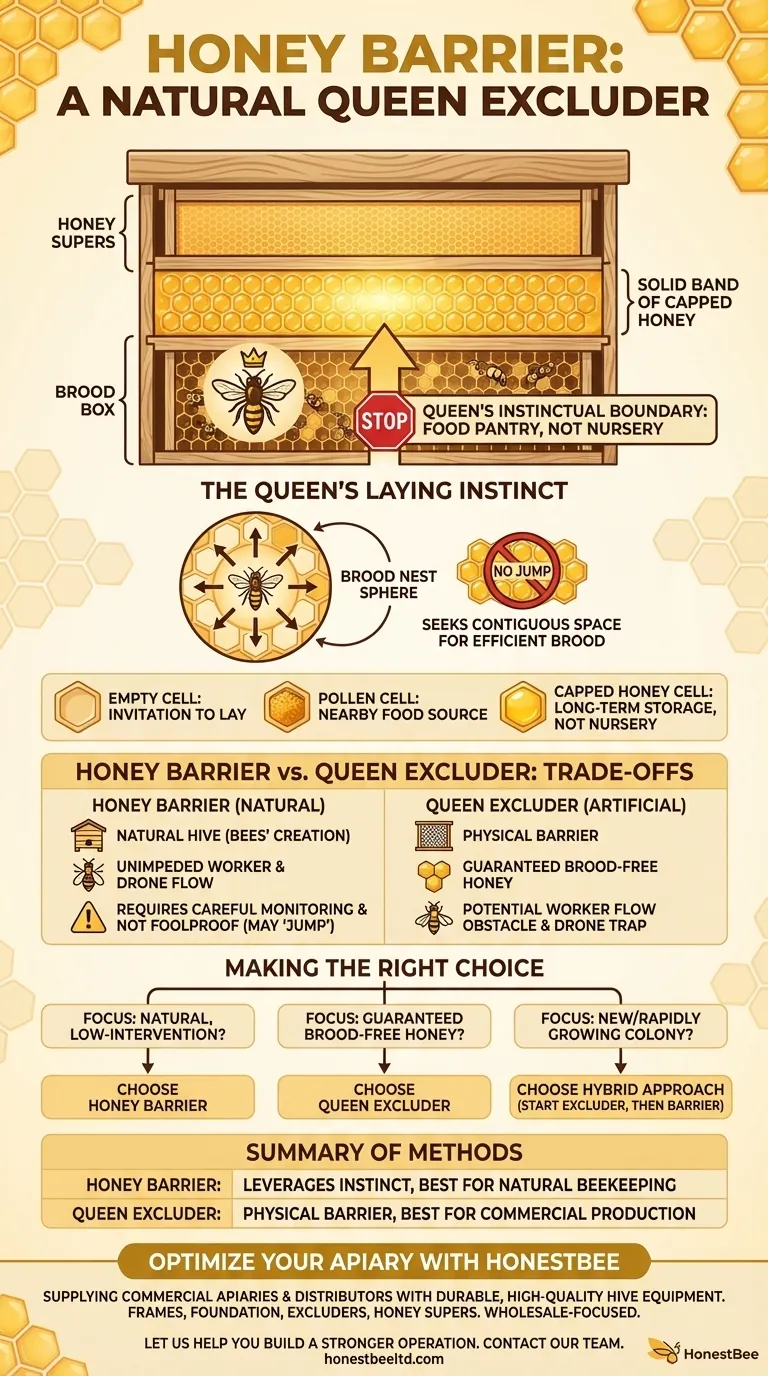The short answer is a queen bee instinctively seeks large, empty areas of comb to lay eggs in a continuous pattern. A solid band of capped honey across a frame acts as a definitive signal that the space above is a food pantry, not a nursery. This instinctual boundary tells her to stop and look for laying space elsewhere, effectively keeping her in the lower brood boxes without a physical barrier.
A honey barrier is not a physical wall, but a powerful behavioral signal. By understanding and leveraging the queen's natural instincts to avoid laying eggs in food stores, a beekeeper can manage brood location without resorting to artificial equipment like a queen excluder.

The Queen's Laying Instinct: The "Why" Behind the Barrier
To understand why a honey barrier works, you must first understand the queen's core biological drive. Her entire purpose is to populate the hive efficiently.
The Search for Contiguous Space
A queen bee does not lay eggs randomly. She seeks out large, unbroken sections of empty cells to create a compact and dense brood pattern.
This behavior is crucial for colony efficiency. A tight cluster of brood is easier for the nurse bees to feed, keep warm, and defend, ensuring the highest survival rate for the next generation of bees.
The "Brood Nest Sphere"
A healthy colony's brood nest naturally forms a spherical or oval shape that spans several frames. The queen works methodically within this sphere, moving from frame to frame to find the next available empty cell.
She is biologically programmed to expand this sphere outwards, but she will not typically "jump" over a significant, filled-in area to start a new, isolated patch of brood.
Reading the Language of the Comb
The queen constantly interprets the contents of each cell. An empty, polished cell is an invitation to lay. A cell with pollen is a nearby food source for larvae.
A cell filled with nectar and capped with wax is a clear signal of long-term food storage. To the queen, a solid wall of capped honey means "pantry," not "nursery," and she instinctively recognizes it as the edge of the viable brood-rearing area.
Honey Barrier vs. Queen Excluder: Understanding the Trade-offs
Using a natural honey barrier is a different management philosophy than using a plastic or metal queen excluder. Each has distinct advantages and disadvantages.
Advantage: A More Natural Hive
A honey barrier is the bees' own creation. It avoids introducing a foreign piece of equipment into the hive, allowing the colony to function with less human-made interference.
Advantage: Unimpeded Worker Flow
Queen excluders, while effective at stopping the queen, can sometimes slow down worker bees as they move up into the honey supers. A natural honey barrier presents no such obstacle, potentially leading to more efficient nectar storage. Drones also cannot pass through an excluder, and they can become trapped above it.
Disadvantage: It Isn't Foolproof
The honey barrier is a strong deterrent, not an absolute guarantee. A young, vigorous queen in a rapidly expanding colony may sometimes "jump" the barrier if she finds a small gap or an empty comb (a "chimney") in the honey super above.
Disadvantage: It Requires Careful Monitoring
This method requires the beekeeper to pay closer attention to the state of the hive. You must ensure the honey barrier is solid and unbroken, especially during a strong nectar flow when the bees are drawing out new comb rapidly.
Making the Right Choice for Your Hive
Your decision to use a honey barrier or an excluder depends entirely on your beekeeping goals and management style.
- If your primary focus is guaranteed brood-free honey: Use a queen excluder. It is the most reliable method for commercial honey producers or hobbyists who cannot risk having eggs in their honey supers.
- If your primary focus is natural, low-intervention beekeeping: Rely on the honey barrier. This method works with the bees' instincts and promotes a more harmonious colony environment.
- If you are managing a new or rapidly growing colony: Consider a hybrid approach. Start with a queen excluder to establish clear separation, and as the hive matures, you may be able to remove it and let a natural honey barrier take over.
By understanding the queen's own instincts, you can guide your colony's growth more effectively and naturally.
Summary Table:
| Method | Key Feature | Best For |
|---|---|---|
| Honey Barrier | Leverages queen's instinct to avoid laying in food stores | Natural, low-intervention beekeeping |
| Queen Excluder | Physical barrier guarantees brood-free honey supers | Commercial producers needing guaranteed results |
Optimize Your Apiary with HONESTBEE
Managing your queen's movement is key to a productive hive. Whether you rely on natural honey barriers or prefer the certainty of a queen excluder, having the right equipment is essential.
HONESTBEE supplies commercial apiaries and beekeeping equipment distributors with the durable, high-quality supplies needed for effective hive management. From frames and foundation to excluders and honey supers, our wholesale-focused operations ensure you get the reliable gear your business depends on.
Let us help you build a stronger, more efficient operation. Contact our team today to discuss your apiary's specific needs.
Visual Guide

Related Products
- Premium Wood Framed Metal Wire Queen Bee Excluder
- Professional Plastic Queen Excluder for Modern Beekeeping
- Metal Queen Bee Excluder for Beekeeping
- Wooden Queen Bee Excluder for Beekeeping
- Plastic Queen Bee Excluder for Bee Hive Wholesale
People Also Ask
- When to put queen excluder on hive? Key Timing for Maximum Honey Production
- Can a queen get through a queen excluder? A Guide to Preventing Hive Failures
- What is the primary function of a queen excluder? A Guide to Brood-Free Honey Harvesting
- Do I really need a queen excluder? A Guide to Maximizing Your Honey Harvest Efficiency
- What makes polyurethane foam environmentally friendly? The Surprising Benefits of a Durable, Inert Material



















